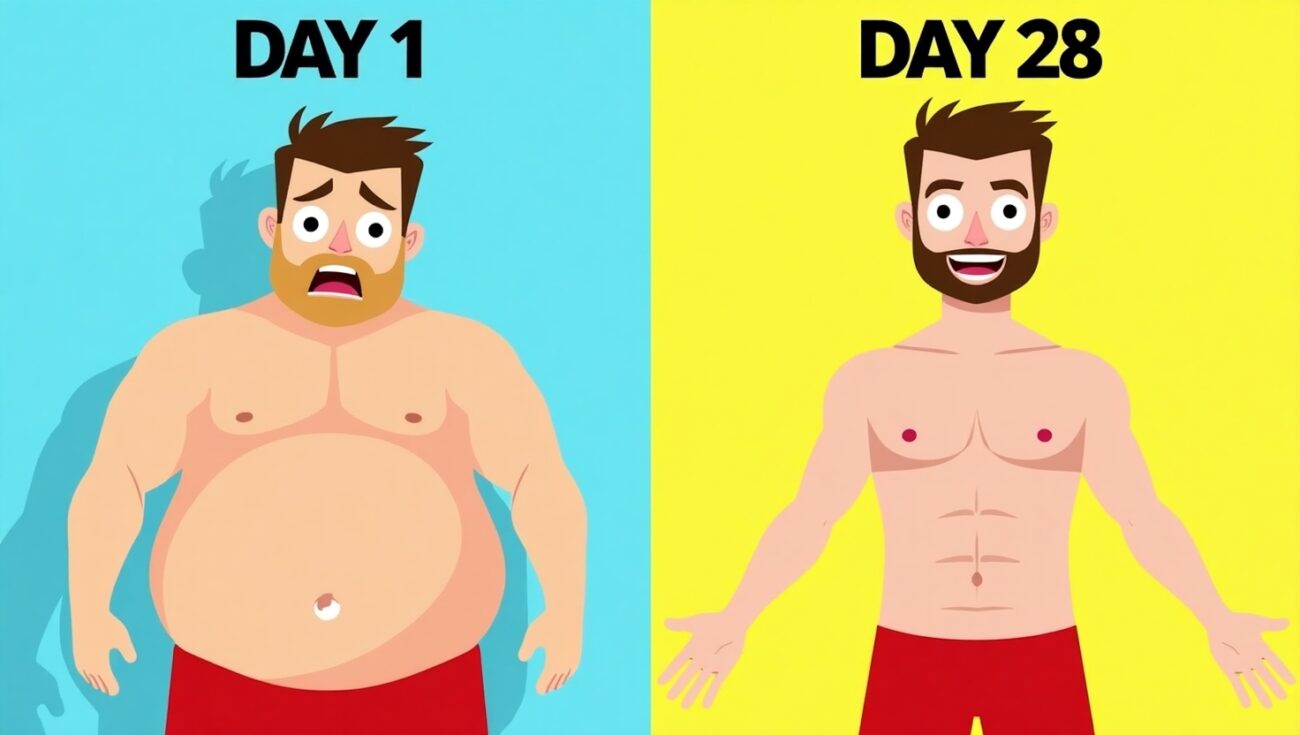lose 10 pounds in a month is a popular goal for many seeking rapid yet safe weight loss. While the promise of quick results is enticing, achieving this goal requires a balanced, evidence-based approach that prioritizes long-term health over temporary fixes. In this guide, we outline a step-by-step strategy that incorporates a calorie deficit, nutrient-dense meal planning, effective exercise routines, and essential lifestyle changes. Whether you’re tracking your calories with apps or following a strict workout plan, the key is to focus on sustainable habits that will serve you well long after the scale shows your target weight.
How to Lose 10 Pounds in a Month: Step-by-Step Strategy
Calculate Your Calorie Deficit
Weight loss is fundamentally about burning more calories than you consume. To shed one pound, you must create a deficit of approximately 3,500 calories. This means that to lose 10 pounds in a month, you need a total deficit of about 35,000 calories over the month—or roughly 1,166 calories per day.
Tips:
- Track Your Intake: Use calorie tracking apps such as MyFitnessPal, Lose It!, or Cronometer to monitor your daily calorie consumption.
- Understand Your Needs: Calculate your Total Daily Energy Expenditure (TDEE) to determine how many calories your body burns daily. Subtracting 500–1,000 calories from your TDEE is a safe deficit for losing 1–2 pounds per week.
- Be Patient: Remember, most healthy weight loss occurs gradually; initial rapid loss might include water weight rather than fat.
READ MORE: Best Exercises For Weight Loss at Home
Prioritize Nutrient-Dense Foods
Eating foods rich in nutrients while being low in empty calories is essential for managing hunger and providing the body with what it needs.
Key Foods:
- High-Protein Sources: Lean meats (chicken breast, turkey), fish, tofu, beans, and low-fat dairy help preserve muscle mass and promote satiety.
- High-Fiber Foods: Vegetables, fruits, whole grains, legumes, and nuts not only fill you up but also aid digestion and stabilize blood sugar.
- Avoid Empty Calories: Limit sugary drinks, processed snacks, and refined carbohydrates which contribute to excess calorie intake without nutritional benefits.
Meal Planning for Success
A well-structured meal plan can be your roadmap to success.
Strategies:
- Sample 7-Day Meal Plan: Create a weekly menu that balances lean proteins, complex carbohydrates, and healthy fats. For example, breakfast might include a veggie omelet with whole-grain toast; lunch could be a quinoa salad with grilled chicken and mixed greens; dinner might feature baked salmon, steamed broccoli, and sweet potato.
- Portion Control: Use measuring cups or a kitchen scale to ensure portions meet your calorie targets.
- Mindful Eating: Eat slowly, savor each bite, and pay attention to hunger cues to avoid overeating.
- Prep Ahead: Spend a day prepping meals for the week so you’re less likely to grab unhealthy options when hunger strikes.
Exercise Routine to Accelerate Weight Loss

Combine Cardio and Strength Training
Integrating both cardiovascular exercise and strength training is crucial for burning calories and building muscle—muscle that in turn boosts your metabolism.
Cardio for Calories:
- HIIT Workouts: High-Intensity Interval Training (HIIT) sessions, which alternate between intense bursts and recovery periods, are highly efficient for burning calories.
- Steady-State Cardio: Running, cycling, brisk walking, or swimming for 30–45 minutes can also raise your heart rate and burn fat.
Strength Training for Muscle:
- Muscle Building: Incorporate resistance exercises like squats, lunges, push-ups, and weightlifting to build lean muscle, which increases your resting metabolic rate.
- Frequency: Aim to strength train at least 2–3 days per week.
RELATED ARTICLE: How to Set Realistic Weight Loss Goals (Without Burnout)
Weekly Workout Schedule
Here’s an example plan to keep you on track:
- Monday: 30–45 minutes of HIIT cardio
- Tuesday: 45 minutes of strength training (full body)
- Wednesday: 30–45 minutes of moderate-intensity cardio (e.g., brisk walking or cycling)
- Thursday: 45 minutes of strength training (upper body focus)
- Friday: 30–45 minutes of HIIT or steady-state cardio
- Saturday: 45 minutes of strength training (lower body focus)
- Sunday: Rest day or light activities like yoga or a gentle walk
Stay Active Throughout the Day
Non-exercise activity thermogenesis (NEAT) plays a significant role in daily calorie expenditure.
Everyday Tips:
- Increase Steps: Consider taking stairs instead of elevators, parking further away from entrances, or even trying “rucking” (walking with a weighted backpack) for added resistance.
- Move Regularly: Set reminders to stand up and stretch or walk for a few minutes every hour if you have a desk job.
- Active Habits: Incorporate simple activities like gardening, dancing, or even a short walk after meals to boost your overall activity level.
Lifestyle Changes to Support Weight Loss

Improve Sleep Quality
Sleep is vital for weight loss as it regulates hunger hormones and supports recovery.
Recommendations:
- Aim for 7–9 Hours: Prioritize a consistent sleep schedule, even on weekends.
- Create a Sleep-Friendly Environment: Keep your bedroom dark, cool, and quiet. Avoid screens at least an hour before bed.
- Establish a Routine: Consider relaxation techniques such as reading or gentle stretching before sleep.
Manage Stress Effectively
Stress can lead to elevated cortisol levels, which may promote fat storage—especially around the midsection.
Stress-Reduction Techniques:
- Mindfulness and Meditation: Practices like deep breathing exercises, meditation, or yoga can help lower stress levels.
- Physical Activity: Regular exercise not only burns calories but also reduces stress.
- Balanced Lifestyle: Ensure you make time for hobbies, social activities, and self-care to maintain overall well-being.
Track Progress and Stay Motivated

Weekly Weigh-Ins and Measurements
Consistent monitoring of your progress can help keep you accountable without becoming obsessive.
Tips:
- Weigh Yourself Weekly: Pick the same day and time each week for consistency.
- Take Body Measurements: Track waist, hip, and other measurements, as the scale doesn’t always reflect changes in body composition.
- Progress Photos: Consider taking photos every few weeks to visually document your transformation.
Celebrate Non-Scale Victories
Weight loss is not solely defined by the number on the scale.
Celebrate Achievements:
- Increased Energy: Notice improvements in how you feel throughout the day.
- Better-Fitting Clothes: Recognize changes in your body shape.
- Enhanced Fitness: Celebrate milestones like increased endurance or strength gains.
- Mood Improvements: Acknowledge any positive changes in your mental health or overall confidence.
Overcoming Weight Loss Plateaus
Adjust Your Calorie Intake
As you lose weight, your caloric needs change.
What to Do:
- Recalculate Your TDEE: Periodically update your calorie goals to reflect your new weight.
- Modify Portions: If weight loss stalls, consider reducing portion sizes or reassessing the nutritional content of your meals.
- Consult a Professional: A registered dietitian can help you adjust your plan as your body adapts.
Switch Up Your Workouts
Plateaus can also result from your body adapting to a consistent exercise routine.
Strategies:
- Vary Intensity and Type: Incorporate different forms of exercise such as new cardio routines or resistance training techniques.
- Interval Training: Mix in more HIIT sessions or try circuit training to keep your muscles challenged.
- Change the Duration: Adjust your workout length or frequency to continue challenging your body and increasing caloric burn.
Safety and Sustainability
Why Slow and Steady Wins
Extreme calorie restriction or overly intense workouts can lead to muscle loss, nutritional deficiencies, and long-term health issues.
Key Points:
- Safe Weight Loss Rates: Aim to lose 1–2 pounds per week as this rate supports fat loss while preserving lean muscle.
- Sustainable Habits: Building lasting habits is more beneficial than quick fixes that often lead to rebound weight gain.
- Listen to Your Body: Extreme measures can lead to burnout or injuries—always prioritize your overall health.
Consult a Healthcare Professional
Before embarking on any aggressive weight loss plan, especially if you have underlying health conditions, it’s important to seek professional advice.
When to Consult:
- Existing Health Issues: If you have conditions such as diabetes, thyroid disorders, or heart issues.
- Unexpected Symptoms: If you experience dizziness, fatigue, or other concerning symptoms during your weight loss journey.
- Personalized Guidance: A healthcare provider or registered dietitian can tailor a plan specific to your needs and ensure that your approach is safe and effective.
Conclusion
Lose 10 pounds in a month is an ambitious goal, but with the right approach, it can be achieved safely and sustainably. The key steps include creating a meaningful calorie deficit, choosing nutrient-dense foods, planning balanced meals, incorporating a mix of cardio and strength training, and making crucial lifestyle adjustments such as improving sleep and managing stress. Remember to track your progress using weekly weigh-ins and measurements, celebrate non-scale victories, and adjust your plan if you hit a plateau. Most importantly, prioritize safety and sustainability by adopting gradual changes and consulting a healthcare professional when necessary.
Embrace long-term habits over quick fixes, and you’ll not only reach your target weight but also maintain your results for years to come.
FAQ
Can You Lose 10 Pounds in a Month Without Exercise?
While exercise significantly accelerates weight loss by burning extra calories and preserving muscle mass, you can still achieve a calorie deficit through diet alone. However, combining even light physical activity with a healthy, calorie-controlled diet improves results and overall well-being.
Is Losing 10 Pounds in a Month Healthy?
For many individuals, losing 10 pounds in a month is possible but should be approached cautiously. A sustainable rate of 1–2 pounds per week is typically recommended to minimize the risk of muscle loss, nutritional deficiencies, and metabolic slowdown. Individual factors such as starting weight and health status will affect the safety and feasibility of this goal.
What Foods Should You Avoid?
Focus on minimizing empty calories by avoiding:
- Sugary beverages and snacks
- Processed foods high in refined carbohydrates and unhealthy fats
- Fried foods and fast foods that offer little nutritional value
Instead, emphasize nutrient-dense options like lean proteins, whole grains, fruits, and vegetables.
For more information on related topics, check out our article on Best Exercises for Weight Loss and explore our meal planning tips with alt text descriptions like “meal-prep-for-10-pound-weight-loss” to optimize your journey.
By adopting these strategies and committing to a balanced, healthy lifestyle, you can achieve your weight loss goals while laying the foundation for a lifetime of well-being.


One thought on “How to Lose 10 Pounds in a Month”